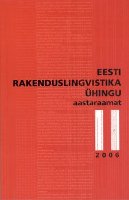Eksamite tagasimõju keeleõppele
Washback of Testing on Language Learning and Teaching
Author(s): Anu-Reet HausenbergSubject(s): Language and Literature Studies
Published by: Eesti Rakenduslingvistika Ühing (ERÜ)
Keywords: language learning and teaching; language testing; Estonian as a second/foreign language
Summary/Abstract: Testing is a common means of assessing knowledge and skills, including language proficiency. ‘Washback’ denotes the influence of examination on the process of learning, which can be either positive or negative. The article explores the notion of washback, introduces some studies on the washback phenomenon in various countries, and focuses on the manifestations of washback on the classes of Estonian as a second language in Russian-speaking secondary schools in Estonia. Previous studies conducted in various countries have shown that testing may change what occurs in language classroom, but it also may have no influence on it. The manifestation and character of washback depends on several aspects, e.g. the purpose of testing and conclusions drawn from results, teacher’s competency, quality of teaching and study materials, form and content (appropriateness for the purpose) of tests, etc. Estonia has a short experience in the organising of standard examinations and the development of tests has begun lately. Washback has become manifest mainly in coaching for typical excercises of the test, so that language learning aims primarily at the examination and not on language proficiency. One may not be able to take a broad view based on the experience of one country or a study of a particular examination, but several studies have brought us to an understanding of how to reduce the negative influence of testing and make the most of the positive washback.
Journal: Eesti Rakenduslingvistika Ühingu aastaraamat
- Issue Year: 2006
- Issue No: 2
- Page Range: 043-052
- Page Count: 9
- Language: Estonian

